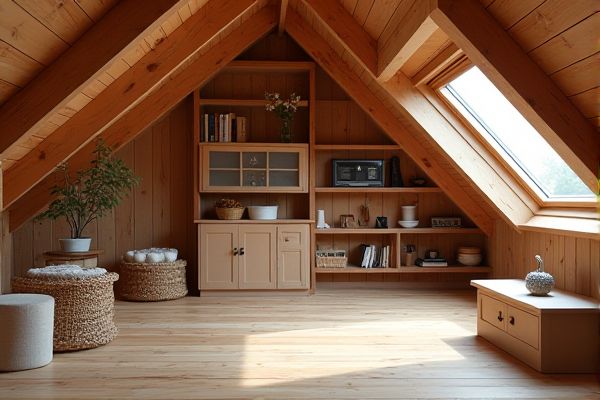
Attic shelving provides open, easily accessible storage ideal for bulky items, while attic cabinets offer enclosed spaces that protect belongings from dust and create a cleaner look. Discover which option best suits your attic organization needs by reading the full article.
Table of Comparison
| Feature | Attic Shelving | Attic Cabinets |
|---|---|---|
| Storage Type | Open shelves for easy access | Enclosed compartments for hidden storage |
| Space Utilization | Maximizes vertical space | Optimizes organization with sections |
| Installation | Simple and quick installation | Requires more complex installation |
| Cost | Generally lower cost | Higher initial investment |
| Protection from Dust | Minimal protection | Better dust and dirt protection |
| Accessibility | Easy to access stored items | Access limited by cabinet doors |
| Aesthetic | Functional, minimal design | Neat and polished look |
| Best Use | Storing large or awkwardly shaped items | Organizing smaller items and tools |
Introduction to Attic Storage Solutions
Attic shelving offers versatile, open storage ideal for organizing boxes, seasonal items, and tools with easy visibility and access. Attic cabinets provide enclosed storage that protects belongings from dust and pests while maintaining a tidier appearance. Choosing the right attic storage solution depends on your specific needs for accessibility, protection, and space optimization.
Understanding Attic Shelving
Attic shelving provides versatile, open storage solutions ideal for organizing seasonal items and maximizing vertical space without the bulkiness of cabinets. Your choice between attic shelving and cabinets depends on factors like accessibility, ventilation, and the need for dust protection; shelving allows easy visibility and air circulation, while cabinets offer enclosed storage to protect belongings from dirt and pests. Optimizing attic shelving can enhance your storage efficiency, making it simpler to sort and retrieve items in often cramped or irregular attic spaces.
Exploring Attic Cabinets
Attic cabinets offer enclosed storage solutions that protect items from dust and pests, making them ideal for long-term organization compared to open attic shelving. These cabinets typically feature durable materials such as plywood or MDF with laminate finishes, ensuring sturdy construction and easy cleaning in the often harsh attic environment. With customizable shelving inside, attic cabinets maximize vertical space and create a more visually appealing storage area while safeguarding seasonal decorations, tools, or archived documents.
Space Efficiency: Shelving vs Cabinets
Attic shelving maximizes space efficiency by offering open, customizable storage that adapts to varying item sizes and shapes, allowing quick access and visibility. In contrast, attic cabinets provide enclosed storage with a tidier appearance but may consume more space due to doors and fixed compartments, potentially limiting storage capacity. Choosing between shelving or cabinets depends on whether prioritizing easy accessibility and flexible organization or a clean, concealed storage solution is more important for the attic layout.
Installation Ease and Flexibility
Attic shelving offers straightforward installation with minimal tools and customizable arrangements, making it ideal for flexible storage solutions in irregular attic spaces. Attic cabinets often require more precise measurements and professional installation but provide enclosed storage that protects items from dust and pests. Your choice depends on whether you prioritize quick setup and adaptability or secure, organized storage.
Cost Comparison: Shelving vs Cabinets
Attic shelving generally costs less than attic cabinets due to simpler materials and easier installation, with typical shelving units ranging from $50 to $200 compared to cabinets that can start around $300 and exceed $1,000 depending on size and customization. Shelving offers a budget-friendly, flexible storage option for lightweight items, while cabinets involve higher expenses but provide enclosed, dust-protected storage that can enhance attic organization. Investment in cabinets may include additional costs for hardware and professional installation, making shelving more cost-effective for basic attic storage needs.
Accessibility and Organization
Attic shelving offers open, easy access to stored items, making it ideal for frequently used belongings and quick retrieval. Attic cabinets provide enclosed storage, protecting items from dust and creating a tidier appearance, which enhances overall organization. Combining both options can maximize accessibility while maintaining a neat and organized attic space.
Durability and Maintenance
Attic cabinets typically offer superior durability compared to open shelving due to their enclosed design, which protects stored items from dust, pests, and moisture damage. Maintenance for attic cabinets is often easier as their closed surfaces require less frequent cleaning, while open attic shelving collects dust and demands regular upkeep to keep items clean. Choosing sturdy materials like metal or high-quality plywood enhances longevity for both options, but cabinets provide better protection and lower maintenance over time.
Best Uses for Shelving and Cabinets
Attic shelving is ideal for storing lightweight items that require easy access and frequent organization, such as seasonal decorations, tools, or holiday boxes. Attic cabinets offer secure, enclosed storage, protecting valuables, sensitive documents, or less frequently used items from dust and pests. Choosing between shelving and cabinets depends on your need for visibility, protection, and the types of items you want to store in your attic.
Choosing the Right Option for Your Attic
Attic shelving offers flexible, open storage ideal for organizing boxes and seasonal items, while attic cabinets provide enclosed space that protects belongings from dust and offers a tidier appearance. Your choice depends on the level of accessibility and protection you need; shelves are perfect for frequently used items, whereas cabinets work better for long-term storage and maintaining a clean environment. Consider the attic's layout, ventilation, and the types of items you'll store to determine which solution maximizes both space and functionality.
 homyna.com
homyna.com